In earlier articles we went over the history and allure of hunting in Africa and calibers for both plains game and dangerous game hunting, this article will take a look at the “must hunt” animals for hunters visiting Africa.
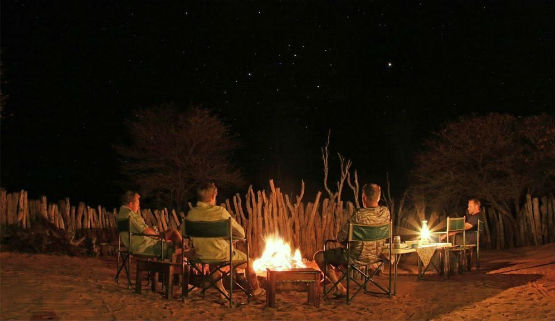
The following is a list of what I think hunters should be looking at when they come to Africa for a hunt.
Africa is a very large and diverse continent, with many species of wildlife available for hunting. In some areas, there can be upwards of 30 different species that a hunter can pursue. In fact, the sheer numbers of wildlife that may be encountered on a single excursion in some places in Africa can overwhelm a hunter, who may only see a handful of animals on a typical hunting trip in the U.K or Europe. Obviously, it’s impossible to go after all of them, so prioritisation is very important.
When making this list, I tried to choose the species that are most often hunted by visiting hunters to Africa. Though the species of animals on this list tend to be the most popular, the list is not intended to merely be a list of the 10 most common animals to hunt in Africa. Instead, I tried to make it a combination of the animals that are most commonly associated with Africa.
Not everyone will have the opportunity to hunt in Africa during their lifetime, but it is a dream that every hunter will wish to try and fulfill.
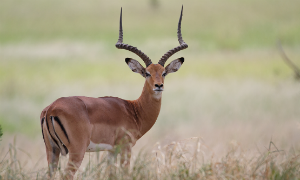 1. Impala are a medium-sized antelope and are possibly the most popular animal to hunt in Africa. They are gregarious animals and large herds of them are commonly observed feeding in the open grasslands that they love. Most often weighing 40 – 75Kg’s, they are approximately the same size and build as a European Fallow deer.
1. Impala are a medium-sized antelope and are possibly the most popular animal to hunt in Africa. They are gregarious animals and large herds of them are commonly observed feeding in the open grasslands that they love. Most often weighing 40 – 75Kg’s, they are approximately the same size and build as a European Fallow deer.
Native to Namibia, South Africa, Botswana, Zimbabwe, Mozambique, Zambia, Malawi, and Tanzania, Impala are a common and relatively inexpensive animal to hunt in Africa over most of their range. In addition to being very common targets for trophy hunters, young rams and ewes provide excellent table fare and are commonly shot for camp meat as well as bait for lion and leopard hunting.
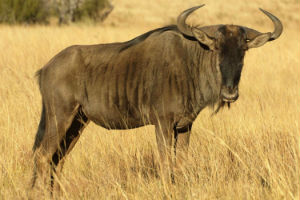 2. Blue Wildebeest are large antelope that, thanks to their long migrations following the rains in Tanzania, are possibly the most often associated with Africa. Blue Wildebeest are grazing animals and live in herds ranging in size from a handful of individuals to thousands of wildebeest. They are most often found in open terrain and are usually in the company of zebra, springbok, and impala.
2. Blue Wildebeest are large antelope that, thanks to their long migrations following the rains in Tanzania, are possibly the most often associated with Africa. Blue Wildebeest are grazing animals and live in herds ranging in size from a handful of individuals to thousands of wildebeest. They are most often found in open terrain and are usually in the company of zebra, springbok, and impala.
Blue Wildebeest typically weigh 240 – 290Kg’sand are recognized as exceptionally tough animals. They are commonly known as the “Poor Man’s Cape Buffalo” for their ability to soak up bullets, seemingly without effect. They live over a wide swath of Africa including Tanzania, Mozambique, Malawi, Zimbabwe, Botswana, South Africa, and Namibia.
 3. Due to their distinctive black and white stripes, zebra are one of the most recognizable animals in Africa. Weighing up to 370 Kg’s, zebra are a species of equids that are somewhat related to horses and donkeys. Though they do not have horns, zebra are often hunted for their unique hides. Since they are also a food source for many predators in Africa, zebra are also hunted to use as bait when hunting leopard and lion.
3. Due to their distinctive black and white stripes, zebra are one of the most recognizable animals in Africa. Weighing up to 370 Kg’s, zebra are a species of equids that are somewhat related to horses and donkeys. Though they do not have horns, zebra are often hunted for their unique hides. Since they are also a food source for many predators in Africa, zebra are also hunted to use as bait when hunting leopard and lion.
Zebra are divided into two primary species: Plains (Burchells) & Mountain Zebra, which accurately describe the habitat they live in. Plains Zebra most often live in open grasslands and are commonly found in large herds in the company of wildebeest. Plains Zebra are extremely common and are found in virtually all of southern and eastern Africa. Mountain Zebra are much less common, live in smaller groups, and are only found in specific parts of South Africa and Namibia.
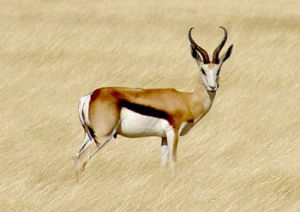 4. Similar in many ways to impala, Springbok are a medium sized species of antelope that usually weigh 35 – 45 Kg’s. Similar to Gemsbok, they inhabit arid and semi-arid areas of South Africa, Botswana, and Namibia.
4. Similar in many ways to impala, Springbok are a medium sized species of antelope that usually weigh 35 – 45 Kg’s. Similar to Gemsbok, they inhabit arid and semi-arid areas of South Africa, Botswana, and Namibia.
Depending on the season, they are either grazers or browsers and are often seen in large herds of up to several hundred animals on the open grasslands of their habitat. They also get all the water they need from their foods and do not need to drink water to survive. Springbok are known for their extremely tasty meat and beautiful hides.
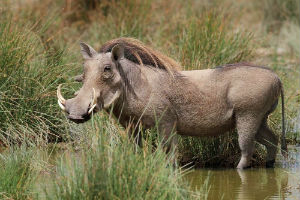 5. The Warthog is a medium sized member of the pig family and typically weighs 70 – 140 Kg’s. They are found all over Africa except for dense forests and deserts. They are among the most reliant of all species in Africa on water and must drink daily to survive. Unfortunately, this also means they are among the first animals to suffer during an extended drought.
5. The Warthog is a medium sized member of the pig family and typically weighs 70 – 140 Kg’s. They are found all over Africa except for dense forests and deserts. They are among the most reliant of all species in Africa on water and must drink daily to survive. Unfortunately, this also means they are among the first animals to suffer during an extended drought.
All warthogs have two sets of tusks, which are basically very large teeth, though males have larger tusks than females. The tusks are used for digging, protection from predators, and for dominance fights between males.
Males have two sets of “warts” on the sides of their face that are actually fat stores and provide protection from other warthogs when they fight. Warthogs are omnivorous and eat a wide variety of food. They are also a source of food for lions, leopards, hyenas, cheetahs, wild dogs, and crocodiles.
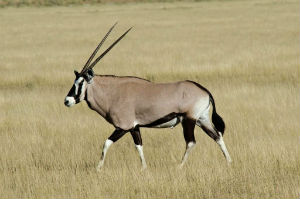 6. Gemsbok are a large species of antelope and usually weigh 220 – 340 Kg’s. Both male and female Gemsbok have long, straight horns. However, males usually have horns that are shorter and thicker when compared to females, which often score higher.
6. Gemsbok are a large species of antelope and usually weigh 220 – 340 Kg’s. Both male and female Gemsbok have long, straight horns. However, males usually have horns that are shorter and thicker when compared to females, which often score higher.
This makes the Gemsbok unusual because females are often pursued instead of males for their longer, more desirable horns. Gemsbok inhabit arid regions of the Kalahari Desert and its surrounding regions in Namibia, Botswana, some areas of Zimbabwe and South Africa.
They are well adapted to life in arid and semi-arid environments and do not need to drink water in order to survive, as they can fulfill all of their water needs through the foods they eat. Gemsbok are also known for being extremely resilient animals and can be very tough to bring down.
 7. Possibly the most graceful and majestic animal on the continent, Greater Kudu have been the objective of many hunters over the years. Greater Kudu are probably best known for their extremely long, spiraling horns.The size of the horn varies, but most adult kudu bulls have horns that measure 45-55 inches, with exceptional kudu having horns around 70″ long. Kudu are among the largest antelope on the continent and usually weigh 275 – 350 Kg’s.
7. Possibly the most graceful and majestic animal on the continent, Greater Kudu have been the objective of many hunters over the years. Greater Kudu are probably best known for their extremely long, spiraling horns.The size of the horn varies, but most adult kudu bulls have horns that measure 45-55 inches, with exceptional kudu having horns around 70″ long. Kudu are among the largest antelope on the continent and usually weigh 275 – 350 Kg’s.
However, they are exceptionally nimble for an animal of their size. Known as the “Grey Ghost,” kudu are can be extremely elusive animals. They inhabit thickly wooded areas from Tanzania down through Mozambique, Zimbabwe, South Africa, and Namibia.
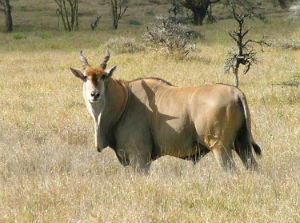 8. The Eland is the largest species of antelope in the world and big bulls may weigh in excess of 2,200 pounds (bigger than a Cape Buffalo). Eland are also a species of spiral horned antelope and both males and females have horns, though the horns on a female are smaller than those on a male.
8. The Eland is the largest species of antelope in the world and big bulls may weigh in excess of 2,200 pounds (bigger than a Cape Buffalo). Eland are also a species of spiral horned antelope and both males and females have horns, though the horns on a female are smaller than those on a male.
Eland inhabit large portions of central, eastern, and southern Africa. They usually live in small herds and are found almost everywhere except for thick forests, deserts, and swamps. They are well adapted to both grazing and browsing and will vary their diet according to the season.
Eland are also very mild mannered and they may be domesticated and finally, Eland are also well known for their delicious meat.
 9. The smallest of the “big cats,” the Leopard is the second member of the “Big 5” on this list. Weighing 120-200 pounds, leopards are opportunistic predators that inhabit a wide range of ecosystems all over Africa. Their diet widely varies depending on the food sources in the area, but they seem to prefer medium sized antelope when given the opportunity. Leopards are very fast and extremely strong. They routinely carry their kills up into trees so that they are out of reach from ground bound predators and scavengers such as hyena.
9. The smallest of the “big cats,” the Leopard is the second member of the “Big 5” on this list. Weighing 120-200 pounds, leopards are opportunistic predators that inhabit a wide range of ecosystems all over Africa. Their diet widely varies depending on the food sources in the area, but they seem to prefer medium sized antelope when given the opportunity. Leopards are very fast and extremely strong. They routinely carry their kills up into trees so that they are out of reach from ground bound predators and scavengers such as hyena.
Unfortunately, their numbers have been on the decline lately and though they still inhabit most of Africa, their populations are much smaller and more fragmented than it used to be. Leopards are shy, solitary, and elusive animals and do most of their hunting at night, so encountering them during the day is rare indeed. The only reliable ways of hunting leopard are with hounds (where legal) or over bait, which is the most common method. Though they are not normally aggressive towards humans, they can be quite dangerous when injured, as many an unfortunate hunter has found out.
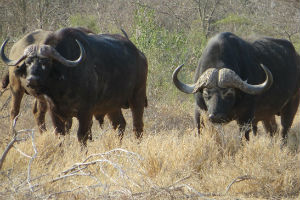 10. Of all ‘dangerous game’, the Cape Buffalo is not only very popular, but also probably the most affordable to hunt. Distantly related to domesticated cattle, Cape buffalo have a reputation for being extremely large, tough, and ill tempered. Big bulls can weigh nearly 1,000 Kg’s have large horns that sweep down before curving upwards and to the rear. Buffalo are grazing animals that live in herds in a wide variety of places in Africa. The main feature that they depend upon is water and they inhabit various swamps, forests, and grasslands in Tanzania, Mozambique, Zambia, Zimbabwe, South Africa, Botswana, and Namibia’s Caprivi Strip.
10. Of all ‘dangerous game’, the Cape Buffalo is not only very popular, but also probably the most affordable to hunt. Distantly related to domesticated cattle, Cape buffalo have a reputation for being extremely large, tough, and ill tempered. Big bulls can weigh nearly 1,000 Kg’s have large horns that sweep down before curving upwards and to the rear. Buffalo are grazing animals that live in herds in a wide variety of places in Africa. The main feature that they depend upon is water and they inhabit various swamps, forests, and grasslands in Tanzania, Mozambique, Zambia, Zimbabwe, South Africa, Botswana, and Namibia’s Caprivi Strip.
Other than man, lions are the only serious predators for adult Cape Buffalo, though crocodiles, leopards, hyenas, and cheetahs will prey on the young, weak, or unwary. Buffalo also have a well-deserved reputation for being extremely aggressive, especially when injured and are sometimes referred to as “The Black Death.” While this nickname probably exaggerates their true nature, they do kill a number of people each year and buffalo charges resulting in injuries are not uncommon.
To read more from Giles follow this link: hunting-the-dark-continent
 (Left: Giles Allcock at the Capreolus Club summer wine tasting event hosted by Holland & Holland)
(Left: Giles Allcock at the Capreolus Club summer wine tasting event hosted by Holland & Holland)
If you are interested in hunting in Africa and would like advice on how to get started then contact:



















